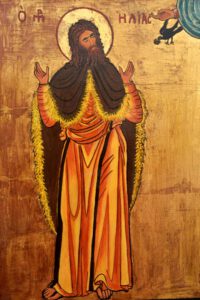Carmel is a mount that figures in the Old Testament. Devotion to Our Lady began there, indirectly, with Prophet Elijah (also called Elias); it culminated in the formation of the Religious Order of the Carmelites in the thirteenth century. It is a fragrance we are still enjoying!
In 1 Kings 19: 16B, 19-21, we meet Elijah, a prophet who lived in Israel nine centuries before Christ. He proclaimed Yahweh, the one true God of the Israelites, against Baal, a false god of the Canaanites. God worked miracles through Elijah as a sign that he was His favoured one. Because of the sins committed in Israel, the Prophet appeared before the evil king Acab and announced a terrible chastisement. There followed a drought throughout the kingdom.
First resurrection
Elijah withdrew to Sarepta and was helped by a poor and honest widow. She had only flour and oil for herself and her son to consume, after which they expected to die. But she counted the Prophet in and the reward was that flour and oil multiplied in the containers. This is a lesson in heroic faith and confidence that we must have in God.
But then, the son died and, all agonised, the woman said to the Prophet: ‘What did I do, oh man of God? Did you come to my house to remind me of my sins and kill my son?’ Elijah called out to God and the Lord heard his prayer: ‘the little boy’s soul returned to him and he won back his life.’ This was the first miracle of resurrection we see in the Old Testament.
 Combative spirit
Combative spirit
After three years in which the kingdom was without dew or rain, Elijah was before the king again. The king asked him: ‘Are you the troublemaker in Israel?’ In a typical example of holy daring or courage, Elijah answered: ‘It is not me who disturbed Israel but you and the house of your father, by abandoning the Lord’s commandments and following Baal.’ Then, turning to the people, he said: ‘When are you going to stop making the mistake of turning to the Lord and to the idol of Baal all at once?’ If the Lord is God, follow him; if Baal is it, follow him.’
Elijah challenged the prophets of Baal to work a miracle. They failed. The people were dumbstruck. Elijah then worked a prodigious miracle on Mount Carmel, bringing fire from heaven for the holocaust, and wood and stones to erect the altar. And the 450 false prophets of Baal, the main responsible for the people’s sins, ‘and Elijah brought them down to the brook Kishon and killed them there.’ (3 Kings: 18: 40) – an example of combativeness for God, a trait lacking in modern man.
Prefiguring the Immaculate Conception
After this healthy and admirable eradication, Elijah began to pray on the Mount. After he implored God to stop the terrible drought, a little cloud began rising from the sea, which soon caused a great shower to fall (3 Kings: 18: 44). This little cloud is interpreted as the symbol of Our Lady and Her Immaculate Conception – because, just as the light and winged cloud rose from the salty sea, without a trace of its bitterness, the Virgin Mary emerged faultless and immaculate from the sea of fallen humanity. Elijah understood this symbolism and was the first to venerate Our Lady.
Elijah’s was snatched from this earth by a chariot of fire. Before that he threw his mantle upon Elisha, who then lived on Mount Carmel. Centuries later, Elijah appeared at the Transfiguration of Our Lord on Mount Tabor and it is believed that he (together with Enoch) will return at the end of the world, to combat the Anti-Christ.
(Talk at Regina Angelorum Cultural Centre, Panjim)
(To be continued: St Simon Stock and the Carmelites – Significance for our day and age)